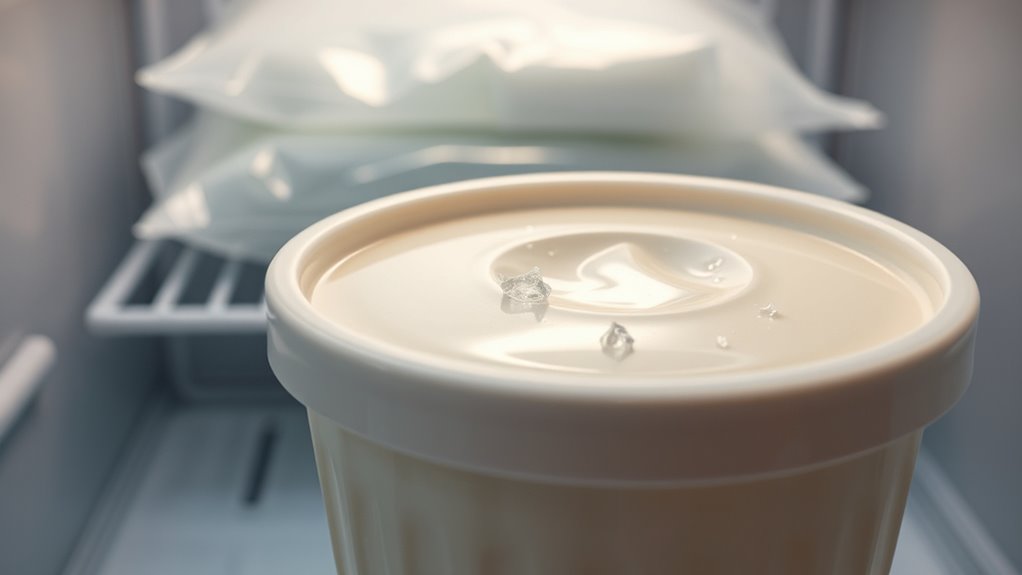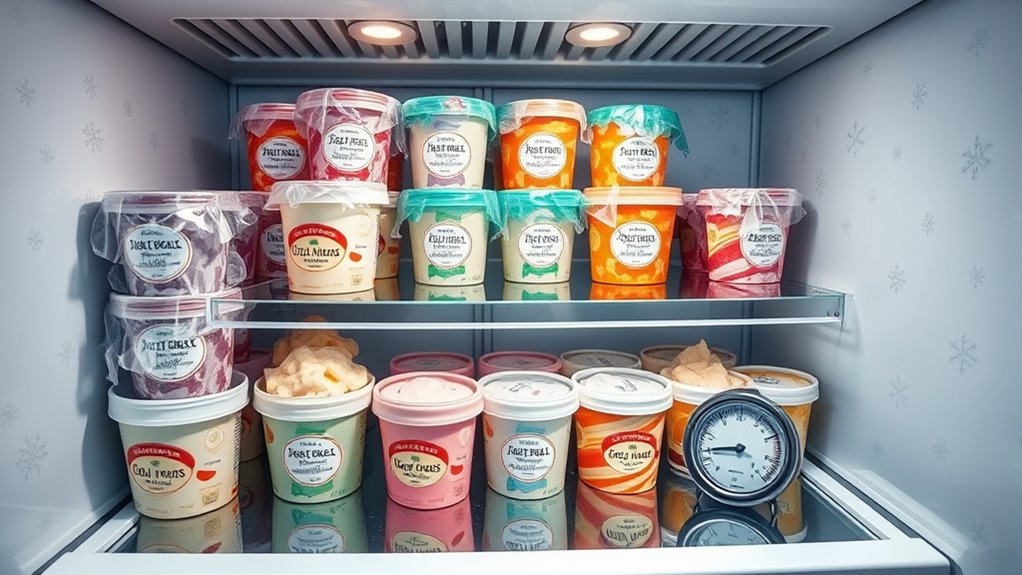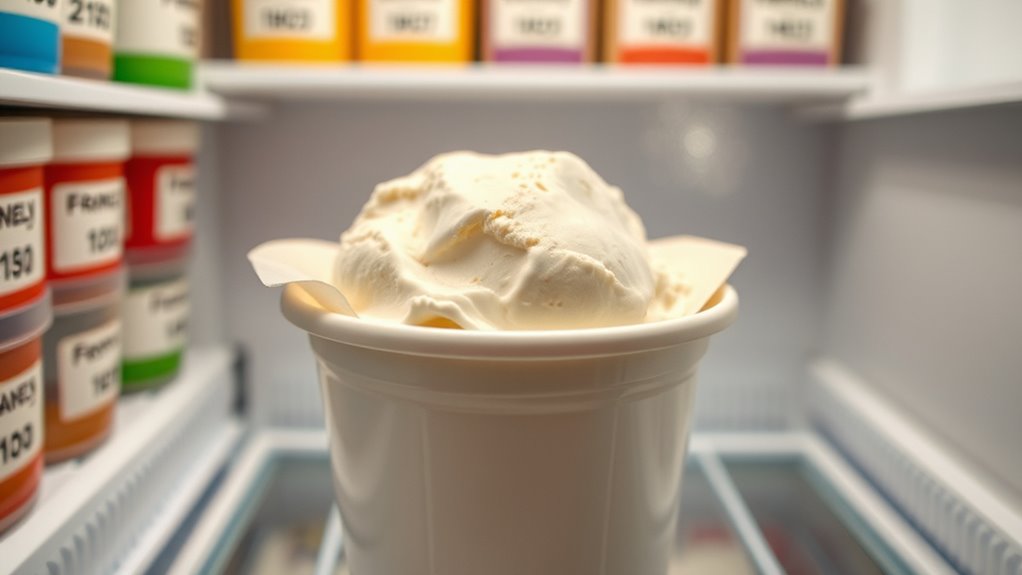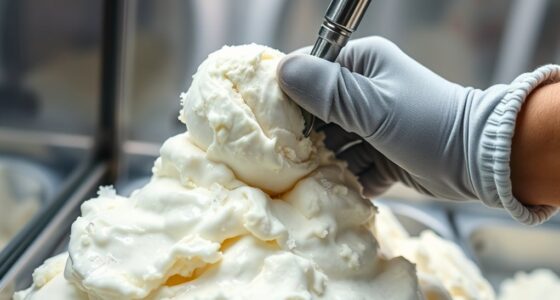To prevent freezer burn on your ice cream, keep it stored below 0°F (-18°C) and minimize air exposure. Use airtight containers, cover the surface with plastic wrap, and store it upside down. Fill containers to the top to reduce empty space, and keep your ice cream at the back of the freezer away from temperature fluctuations. Use a cold scoop when serving, and enjoy it quickly to maintain its creamy texture. There’s more to discover about effective storage techniques!
Key Takeaways
- Store ice cream in airtight containers to limit air exposure and prevent freezer burn.
- Cover the surface with plastic wrap or wax paper before sealing the container.
- Keep ice cream in the coldest part of the freezer, ideally below 0°F (-18°C).
- Minimize opening the freezer to maintain stable temperature and humidity levels.
- Consume ice cream within a month of purchase for optimal flavor and texture.
Proper Freezer Temperature Management

When it comes to storing ice cream, managing your freezer’s temperature is crucial for maintaining its quality and preventing freezer burn.
Ideally, keep your freezer between -16°C to -22°C (3°F to -8°F) for the best texture and flavor. To prevent freezer burn, make certain the temperature stays below 0°F (-18°C), which limits the formation of large ice crystals. Using ice cream hardening freezers can further enhance texture by operating between 0°F and -40°F. Regularly check the temperature with a thermometer, and consider investing in a freezer with built-in temperature sensors for real-time monitoring. Ice cream hardening freezers are designed to rapidly freeze ice cream, locking in its texture and flavor, which can be beneficial for long-term storage. Additionally, maintaining a consistent freezer temperature is important as it helps to prevent ice crystal formation and preserve the creamy texture of your ice cream. When ice cream is stored properly, it can maintain its creamy texture similar to popular ice cream varieties like Birthday Cake or Neapolitan. Furthermore, utilizing moisture-resistant materials in storage containers can also help preserve ice cream quality by preventing excess air exposure. Proper temperature management is key to preventing ice crystal formation that can affect the overall enjoyment of your ice cream. Additionally, the use of advanced refrigeration technology can help achieve optimal freezing conditions for your ice cream.
Minimizing Air Exposure

To keep your ice cream fresh and delicious, minimizing air exposure is crucial. Air causes freezer burn by allowing moisture to escape, so cover the ice cream surface with plastic wrap, wax paper, or parchment paper to block it. Use airtight containers or heavy-duty freezer bags for added protection. Storing the container upside down can help prevent freezer burn, as any melted ice cream will drip onto the lid instead of the surface. Additionally, ensure that your freezer is set to the best freezer temperature to help maintain ice cream quality. The churning process in ice cream recipes can also influence texture and prevent air pockets that lead to freezer burn. Chia seeds are an example of a food that benefits from proper storage to maintain their quality. Place your ice cream in the back of the freezer to reduce its exposure to warm air each time you open the door. Finally, always verify your containers have tight-fitting lids and check for any wear that could compromise their seal.
Effective Ice Cream Storage Techniques

Effective ice cream storage techniques can make all the difference in preserving your favorite treats.
Start by choosing airtight containers made of plastic, glass, or metal that withstand low temperatures. Quart-sized containers are perfect for portion control, while reusable silicone bags work great for smaller amounts. Proper storage techniques ensure that your homemade ice cream maintains its quality for an extended period, especially since average ice cream consumption is about 23 pounds annually in the U.S. To maintain the freshness of your ice cream, consider using containers that are also designed to reduce exposure to air. Herbal teas like chamomile tea can promote relaxation, which may be beneficial for overall enjoyment during dessert time. Additionally, keeping ice cream consumption in moderation can help prevent health issues associated with high sugar and fat content. Ensuring that your freezer is set to the appropriate temperature improves air purification efficiency, which can help in maintaining the overall quality of frozen foods.
Store your ice cream at temperatures below 0°F, ideally around -15°C (5°F), and keep it in the coldest part of the freezer, away from the door.
To further prevent freezer burn, cover the ice cream surface with plastic wrap or aluminum foil and guarantee the lid is tightly sealed.
Label containers with dates and flavors, and always use a cold scoop to serve, maintaining the ice cream’s quality and freshness.
Avoiding Refreezing and Temperature Fluctuations

Maintaining a consistent temperature in your freezer is essential for preventing ice cream from developing freezer burn. Keep your freezer below 0°F to avoid ice crystal formation, which can ruin texture and flavor. Freezer burn occurs when ice cream is exposed to cold, dry air, so sealing the container tightly is crucial if you need to refreeze. If you need to refreeze, make sure the container is sealed tightly to minimize air exposure, as moisture loss during refreezing accelerates freezer burn. Additionally, consider that caffeine content can be affected by temperature fluctuations, which may influence other frozen treats like coffee ice cream. Storing ice cream at the back of the freezer helps protect it from temperature fluctuations caused by door openings, as high-fat ice creams may be more susceptible to texture changes. To ensure optimal freshness, regularly monitor filter replacement for your freezer’s air quality if it has a built-in purification system. Implementing effective payment solutions in your food business can also enhance customer satisfaction by ensuring quick and easy payment processing. To serve portions quickly and reduce melt time, use a serrated knife instead of letting the ice cream sit out. It’s also important to regularly check for signs of freezer damage to ensure your ice cream stays fresh.
Moisture Control in the Freezer

Moisture control in your freezer is essential for preserving the quality of ice cream and preventing freezer burn.
To start, keep your freezer temperature below 0°F (-18°C) to minimize moisture impact. Guarantee the freezer is properly sealed to block warm, moist air from entering. Regular maintenance ensures that your freezer continues to operate efficiently, reducing the risk of moisture buildup. Additionally, energy-efficient systems can help maintain optimal freezer performance and reduce energy costs. Implementing energy efficiency evaluations can further enhance your freezer’s efficiency. Geothermal heat pumps, with their renewable energy source, can significantly reduce your overall energy consumption, further aiding in moisture control.
Regularly clean the freezer to eliminate food residue that might contribute to excess moisture. When storing ice cream, use airtight containers and fill them completely to reduce air exposure. Cover the surface with plastic wrap or aluminum foil to further protect against moisture. Limit how often you open the freezer to maintain stable humidity levels.
Best Practices for Ice Cream Consumption and Maintenance

To enjoy ice cream at its best, you need to follow some simple yet effective practices for consumption and maintenance. Store your ice cream at temperatures below 0°F, away from the freezer door, to avoid temperature fluctuations. Use air-tight containers to keep air out and prevent flavor contamination from strong odors. When serving, use a cold scoop to minimize melting and limit portions to ½ cup or 1 scoop for balance. Enhance your treat with healthy toppings like nuts or fresh fruits, as choosing healthy toppings can enhance the overall healthiness of ice cream. After serving, cover the remaining ice cream with wax paper or plastic wrap before returning it to the freezer. For ideal flavor and texture, consume it within a month of purchase.
Enjoy responsibly!
Frequently Asked Questions
Can Freezer Burn Affect the Flavor of Ice Cream?
Imagine savoring a perfectly creamy scoop of ice cream, only to find it dry and bland due to freezer burn.
Yes, freezer burn can greatly affect the flavor, leaving you with an unappealing taste experience. The ice crystals and moisture loss compromise the richness you crave.
While it’s still safe to eat, the joy of that delightful dessert is lost, and you’re left longing for the original, luscious flavor you once loved.
How Long Can Ice Cream Last in the Freezer?
Ice cream can last quite a while in the freezer, but it depends on how you store it.
If you keep it unopened in the coldest part of the freezer, it can last about 2 to 4 months.
Once opened, it’s best to consume it within 1 to 2 months for ideal freshness.
Always check for signs of spoilage like off-flavors or ice crystals to guarantee you’re enjoying the best quality.
Is It Safe to Eat Freezer-Burned Ice Cream?
Think of freezer-burned ice cream like a worn-out sweater; it mightn’t look or feel great, but it’s still safe to wear!
Yes, you can eat freezer-burned ice cream according to USDA guidelines. While it won’t be as creamy and flavorful, it won’t harm you.
Just be prepared for a different texture and taste. If it’s too icy for your liking, blend it into a milkshake or smoothie for a delicious fix!
What Are the Signs of Freezer Burn on Ice Cream?
You’ll notice signs of freezer burn on ice cream when you see ice crystals forming on the surface, giving it a frosty look.
The texture changes, becoming icy and crunchy instead of smooth and creamy. It may taste dry and flavorless, and you might find gritty patches.
Often, a thin sheet of frost covers the top, making it less appealing. While it’s safe to eat, the quality definitely suffers.
Should I Store Ice Cream in Its Original Container?
Storing ice cream in its original container is like keeping a treasure in its chest—it’s convenient and helps maintain its identity.
You’ll find that the original packaging retains shape and minimizes mess, making it easier to scoop. However, it mightn’t be airtight enough, risking freezer burn.
If you want to keep that creamy goodness intact, consider using an airtight container for better protection and freshness.
Enjoy that sweet scoop!
Conclusion
By embracing these storage tips, you can keep your ice cream as delightful as a summer day. Maintaining the right temperature, minimizing air exposure, and controlling moisture will guarantee each scoop is a creamy masterpiece rather than a frosty disappointment. Remember, protecting your frozen treasure from refreezing and temperature swings is key to preserving its luscious texture. So, savor every bite and let your ice cream experience be as sweet as the memories it brings.










